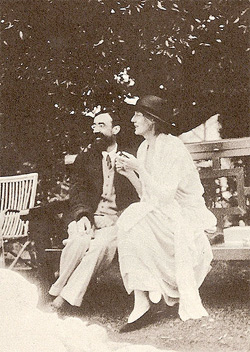Since the 1960s, the history of sex has transformed from sleazy sideline to respectable subject of academic study. The following is a timeline of the lesser-known scholarly discoveries that inform our erotic thinking today.
c. 1700: Sex “invented.”
“Some time in the 18th century, sex as we know it was invented,” writes Berkeley historian Thomas W. Laqueur. Before that time, Laqueur argues, most anatomists accepted the ancient idea expressed by the Greek doctor Galen that there was really only one gender: Women’s sexual organs were essentially the same as men’s, except they were inverted due to a lack of “vital heat.” The vagina was matched by penis, the ovaries by the testicles (“stones of women”), the labia by the foreskin, the uterus by the scrotum. This appealed to classical notions of cosmic harmony, and allowed doctors to argue that women were simply inferior versions of men. But in the 18th century, scientists began to see men and women as complete biological opposites – profoundly different creatures, distinct in body, character and even soul. (This was no great improvement for women’s rights, since male thinkers promptly argued that men were “sexually charged” and essentially active, and that women were essentially passive).
c. 1730: Female orgasm officially demoted.
For most of Western history, doctors believed (despite some fairly obvious evidence to the contrary) that conception could only occur when both men and women experienced sexual pleasure; this immutable law of nature was even written into many handbooks for midwives in the Renaissance. Scholars believed the buildup of “female semen” in unsatisfied women could be downright dangerous, resulting in hysteria and melancholia. Then, around 1730, anatomists proved that the female orgasm was not essential for reproduction. The Dark Age of the bedroom had begun, as male medical experts played down the importance of female satisfaction to the sex act and to women’s happiness in general. By the Victorian era, doctors were asserting that women were not, in fact, capable of a true orgasm. “As a general rule,” intoned the English urologist William Acton in 1875, “a modest woman seldom desires any gratification for herself. She submits to her husband’s embraces, but principally to gratify him; and were it not for the desire of maternity, would far rather be relieve of his attentions.”
1864: Smut identified.
The word “pornography” first appeared in the English language at the height of the Victorian period, when Webster’s Dictionary listed it in 1864 to describe “licentious painting employed to decorate the walls of rooms sacred to bacchanalian orgies examples of which occur in Pompeii.” The word had actually been invented in Italian four years earlier by the Neapolitan museum curator Giuseppe Fiorelli, when he wrote a brief catalog to the notorious Secret Cabinet of the Naples Museum, packed with ancient Roman erotic art for discerning (and generally lascivious) visitors. Fiorelli combined the ancient Greek word for prostitutes, pornai, with writing, graphos, to describe the restricted-access collection. Over time, pornography became synonymous with any image that should be viewed privately and furtively. Cultural censorship had been born.
1892: Homosexuality acknowledged.
It wasn’t until 1892, three years before the Oscar Wilde trials, that the word “homosexual” entered the English language, when an 1868 work by the Austrian sexologist Richard Freiherr von Krafft-Ebbing, Psychopathia Sexualis, was translated. (Along with this “male-on-male activity,” the word “bisexual” also premiered in the same opus). Although sodomy had been illegal in Britain since 1533 — and a capital offense since 1562 — men had never been labeled purely “gay” or “straight.” Obviously, this is not to say that homosexual activity did not exist. Far from it. In ancient Greece, it was openly acceptable for men to have physical relations with teenage boys. In the Middle Ages, the prodigious amount of homosexual behavior was regarded as just one of the many categories of carnal sin, to be dealt with by priests and church courts, not the state. However, as the 19th century wore on, there was an increasing tendency for men to define themselves — and be defined by the law — as part of a distinct sexual category, either heterosexual, homosexual, or bisexual. Although the death penalty was dropped from sodomy charges in the 1860s, pressure built for the passage of the Criminal Law Amendment Act in 1885, which made acts of “gross indecency” between males “in public or in private” subject to two years of hard labor. The criminalization of homosexuality, copied in the United States, remained on the books until the 1960s.
1908: Age of Aquarius forseen.
According to Virginia Woolf, the modern world began on the day fellow author Lytton Strachey visited her apartment and, pointing to a stain on her friend Vanessa Stephen’s dress, inquired politely, “Semen?” The upper-crust Bloomsbury author was impressed by the refreshing openness about the body, which she contrasted to the hypocrisy of the 19th century: “It was, I think, a great advance in civilization.”
As if to confirm her conviction, a mini sexual revolution got underway after the First World War, heralded by popular books such as Dr. Harland Long’s Sane Sex Life and Sane Sex Living (1919) and Dr. Lee Harlan Stone’s classic It is Sex O’Clock (1928). • 28 September 2010
SOURCE/FURTHER READING: Allen, Peter Lewis, The Wages of Sin: Sex and Disease, Past and Present, (Chicago, 2000); Connell S.M., “Aristotle and Galen on sex difference and reproduction,” Studies in History and Philosophy of Science, 2000 (Sept), 31 (3), 405-27; Katz, Jonathan Ned, “Coming to Terms: Conceptualizing Men’s Erotic and Affectional Relations with Men n the United States, 1820-1892,” in Duberman, Martin (ed.), A Queer World: The Center for Lesbian and Gay Studies Reader, (New York, 1997); Kendrick, Walter, The Secret Museum: Pornography in Modern Culture, (Berkeley, 1996); Laqueur, Thomas W., Making Sex: Body and Gender from the Greeks to Freud, Harvard 1990; Woolf, Virginia, “Old Bloomsbury” in Moments of Being (London, 1985); Salaman, Naomi, “The Taxonomic Effect,” www.art-omma.org, 10.




